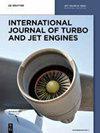基于叶片高度的多级轴流涡轮一维性能预测研究
IF 0.9
4区 工程技术
Q4 ENGINEERING, AEROSPACE
引用次数: 0
摘要
摘要随着涡轮机运行条件的变化,由于热应力、气动力和离心力的共同作用,叶片高度和叶尖间隙会不断变化,从而影响涡轮机的性能。为了在汽轮机性能预测中考虑这种影响,本研究考虑了流体-热结构耦合对叶片高度和叶尖间隙的影响,建立了考虑叶片高度的多级轴流式汽轮机性能的一维综合预测方法。与四级轴流涡轮机的实验结果相比,通过考虑流体-热-固耦合效应,总压比预测的平均相对误差从3.76减小 % 至1.99 % 总温比预测的平均相对误差从2.03降低 % 至1.26 %. 与传统的流量预测方法相比,本文考虑叶片高度和叶尖间隙变化的涡轮特性预测结果更接近实验结果。本文章由计算机程序翻译,如有差异,请以英文原文为准。
Study on one-dimensional performance prediction of multi-stage axial turbine based on the blade height
Abstract As turbine operating conditions change, the blade height and tip clearance undergo continuous alterations due to the combined effects of thermal stress, aerodynamic forces and centrifugal forces, subsequently influencing the turbine performance. To take this effect into account in turbine performance prediction, this study considers the influence of fluid-heat-structure coupling on blade height and tip clearance and establishes a one-dimensional comprehensive prediction method for multi-stage axial turbine performance considering blade height. When compared with experimental results from a four-stage axial turbine, by considering the fluid-thermal-solid coupling effects, the average relative error in total pressure ratio prediction is reduced from 3.76 % to 1.99 % and the average relative error in total temperature ratio prediction is reduced from 2.03 % to 1.26 %. Compared with the traditional flow prediction method, the prediction results of turbine characteristics considering blade height and tip clearance changes in this paper are closer to the experimental results.
求助全文
通过发布文献求助,成功后即可免费获取论文全文。
去求助
来源期刊

International Journal of Turbo & Jet-Engines
工程技术-工程:宇航
CiteScore
1.90
自引率
11.10%
发文量
36
审稿时长
6 months
期刊介绍:
The Main aim and scope of this Journal is to help improve each separate components R&D and superimpose separated results to get integrated systems by striving to reach the overall advanced design and benefits by integrating: (a) Physics, Aero, and Stealth Thermodynamics in simulations by flying unmanned or manned prototypes supported by integrated Computer Simulations based on: (b) Component R&D of: (i) Turbo and Jet-Engines, (ii) Airframe, (iii) Helmet-Aiming-Systems and Ammunition based on: (c) Anticipated New Programs Missions based on (d) IMPROVED RELIABILITY, DURABILITY, ECONOMICS, TACTICS, STRATEGIES and EDUCATION in both the civil and military domains of Turbo and Jet Engines.
The International Journal of Turbo & Jet Engines is devoted to cutting edge research in theory and design of propagation of jet aircraft. It serves as an international publication organ for new ideas, insights and results from industry and academic research on thermodynamics, combustion, behavior of related materials at high temperatures, turbine and engine design, thrust vectoring and flight control as well as energy and environmental issues.
 求助内容:
求助内容: 应助结果提醒方式:
应助结果提醒方式:


